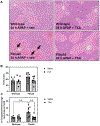Fibrinolysis-Mediated Pathways in Acute Liver Injury
- PMID: 38395065
- PMCID: PMC11397073
- DOI: 10.1055/s-0044-1779738
Fibrinolysis-Mediated Pathways in Acute Liver Injury
Abstract
Acute liver injury (ALI), that is, the development of reduced liver function in patients without preexisting liver disease, can result from a wide range of causes, such as viral or bacterial infection, autoimmune disease, or adverse reaction to prescription and over-the-counter medications. ALI patients present with a complex coagulopathy, characterized by both hypercoagulable and hypocoagulable features. Similarly, ALI patients display a profound dysregulation of the fibrinolytic system with the vast majority of patients presenting with a hypofibrinolytic phenotype. Decades of research in experimental acute liver injury in mice suggest that fibrinolytic proteins, including plasmin(ogen), plasminogen activators, fibrinolysis inhibitors, and fibrin(ogen), can contribute to initial hepatotoxicity and/or stimulate liver repair. This review summarizes major experimental findings regarding the role of fibrinolytic factors in ALI from the last approximately 30 years and identifies unanswered questions, as well as highlighting areas for future research.
Thieme. All rights reserved.
Conflict of interest statement
None declared.
Figures


References
-
- Trey C. The management of fulminant hepatic failure. Progress in liver diseases. 1970. - PubMed
-
- Wendon J, Cordoba J, Dhawan A, et al. EASL Clinical Practical Guidelines on the management of acute (fulminant) liver failure. Journal of Hepatology. 2017;66(5):1047–81. - PubMed
-
- Larson AM, Polson J, Fontana RJ, et al. Acetaminophen-induced acute liver failure: results of a United States multicenter, prospective study. Hepatology. 2005;42(6):1364–72. - PubMed
-
- EASL Clinical Practice Guidelines: Drug-induced liver injury. J Hepatol. 2019;70(6):1222–61. - PubMed
Publication types
MeSH terms
Grants and funding
LinkOut - more resources
Full Text Sources

